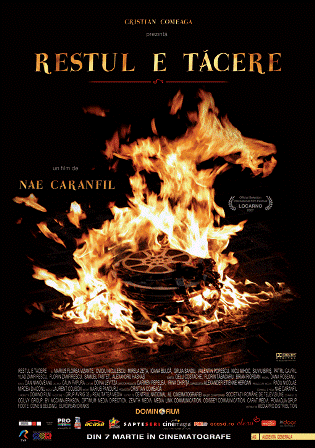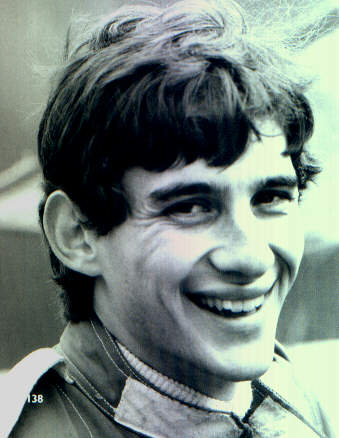One of the reasons I like going to Shang, aside from the quiet and
space due to the lack of crowds other malls normally have, is that they play
host to different film festivals in which, for the sad unawares, admission is free.
These past two weeks, Cine Europa, which showcased films from (surprise,
surprise!) different European countries, was held. Compared to film fests in
the past, the crowd of attendees this year has grown much bigger. It unsettled
me that most who were there had no other reason in watching aside from the fact
that it’s free. It made me feel bad that the movies were playing for the wrong
audience who, being used to watching visually-arresting but mindless
blockbusters, might not appreciate them. But, as my sister wisely pointed out, it
can also serve as an avenue to educate people that there also films of
substance out there that they can enjoy.
Out of the many films on schedule, I had the chance to watch three
films, which was plenty enough for me. These three were all different from
their country of origin, decade where they belonged, the storyline, of course,
and the general atmosphere of the movie.
The first movie I was able to see was “Lidice” from Czech Republic. Because
we had decided at the last minute to watch due to its convenience of time, we
lined up, utterly clueless of what we were about to see. Had I known what was
coming, I would have a very different reaction altogether.
 From the first few seconds of the film, it was apparent that there
would be no laughing involved. What we did not expect, was that it was a Nazi
movie. Lidice, as it turns out, was an actual town, which took the fall for the
assassination of a high-ranking official. Frantic to find a scapegoat, an
innocent letter from Lidice was purposely misinterpreted and used as evidence
for the shooting. The result was a town genocide of horrendous proportions. I
will no longer describe the details beyond the words death by weighing scale
and gas chamber trucks. The protagonist was the only male survivor of the town
because he was in prison when the whole thing happened. He had no knowledge of
the incident until he, as a free man, found himself standing on a wide patch of
snow where the town used to be. The story has more to it, with its sub-plots,
but you get the drift. Although I should do more than tell the story and at
least give a reaction to the film other than exclaiming my horror, I cannot get past the lifeless faces of the
dead and the anguished cries of the mothers to see it as a movie and not as
history unfolding itself. If I have
learned anything from this film, it’s that one Nazi movie is enough to watch
for a lifetime and in my case, I had two (“Life is Beautiful”). So much for
including “Schinder’s List” on my bucket list.
From the first few seconds of the film, it was apparent that there
would be no laughing involved. What we did not expect, was that it was a Nazi
movie. Lidice, as it turns out, was an actual town, which took the fall for the
assassination of a high-ranking official. Frantic to find a scapegoat, an
innocent letter from Lidice was purposely misinterpreted and used as evidence
for the shooting. The result was a town genocide of horrendous proportions. I
will no longer describe the details beyond the words death by weighing scale
and gas chamber trucks. The protagonist was the only male survivor of the town
because he was in prison when the whole thing happened. He had no knowledge of
the incident until he, as a free man, found himself standing on a wide patch of
snow where the town used to be. The story has more to it, with its sub-plots,
but you get the drift. Although I should do more than tell the story and at
least give a reaction to the film other than exclaiming my horror, I cannot get past the lifeless faces of the
dead and the anguished cries of the mothers to see it as a movie and not as
history unfolding itself. If I have
learned anything from this film, it’s that one Nazi movie is enough to watch
for a lifetime and in my case, I had two (“Life is Beautiful”). So much for
including “Schinder’s List” on my bucket list.
Determined not to make the same mistake of watching unknowingly, I
read the synopsis of “The Rest is Silence” (Romania) before heading out.
Because it was a labeled as a comedy and as one review puts it, “an intelligent
crowd-pleaser”, I was all set to watch. And I was not disappointed. The film is
about the making of the first full-length feature film about the war in
Romania. In a time where the theatre is watched in throngs, short silent films
are a big joke to the arts. And so, it was a huge feat, that a two-hour long
film, ambitious as it was, was completed. It highly contrasts the two
performance arts. “Hamlet” in theatre is a four-hour long show of colourful
and elaborate costumes and poignant poetry uttered with the grace and eloquence that can only be perfected by years of study. Whereas, in film, it is only a ten-minute sequence
of black and white images, with the actors gesturing wildly as they have to
convey emotions without any audible dialogue and assisted with short
intertitles instead.
 |
Carol I: A "director"...?... So what the
hell does this child do?
Grig:
Me, I reign, Sire!
|
The film is ridden with hapless but comical
situations brought to life by characters with their flamboyant personas. The chubby
young director, determined to break film grounds despite the objections of his
father, who happened to be a renowned comic theatre actor. The investor, albeit
his reservations, upon watching his first short film cracked up the most long after
the laughters have ended. And the
mysterious, beautiful lady, who after the director’s first encounter with her, which was seeing her posing with her breasts au naturale for a painting, keeps popping up in his life. But true
to the movie’s promise of a tragedy-comedy, the characters took the turn for
the worst, as they faced their dreadful and lonely endings. Still, the somber
ending did not taint the post-movie glow I have whenever I enjoyed watching.
And as to the title “The Rest is Silence”, aside from the reference to silent
films, it was drawn from the last line uttered in “Hamlet” right before he died,
which also pertained to the death of the movie characters.
 |
| Being second is to be the first of the ones who lose. |
The film I am most excited about is “Senna”
(UK). It is a actually, a documentary of Ayrton Senna, a racing driver legend. He is the
Manny Pacquaio of Brazil, only handsome. He has three Formula One World
Championships under his belt and numerous podium finishes. In every win, he
never hesitates to wave his Brazilian flag up high (literally), a testament
that he is proud of his roots.
The documentary captures the very first
time he raced in Europe, up to that faithful day of his untimely death. It features
footages from the races, including his in-car camera, interviews, and
closed-door meetings. We are given front row seats to the highs and lows of his
career, which I never imagined to be ridden with so much controversy and drama. It was as if
his life was made for television. I
never knew of his existence before I sat down and watched him on the screen but
his death affected me so even though I am 18 years too late. I guess that’s our
general reaction whenever someone still young and at the peak of his career
dies.
In the first few minutes upon realizing that the film was nothing
more than a documentary of some race car driver, a
number of people made their way out of the theatre. Some tried to hold their
ground but eventually followed suit. It was a documentary and not a biopic
because despite the lack of glitz and glamour one could in add in films, it
would be hard to capture the raw intensity, uproars of the spectators, and the breathless
anticipation of every turn in the tracks from watching the real thing. I myself
don’t really watch documentaries but this one was able to get me to hold on to
my seat. It took some strategic emphasis, camera angles, and the right
commentaries to make it as exciting as it can get. I don’t know if it was
intentional but the bromance relationship between Senna and his doctor was a happy
departure from the grim scenes presented. It got me laughing when the doctor
said that “His (Senna’s) face lights up whenever he sees me.”
I’ve written more than I intended to and I have to stop myself from
gushing about Senna’s cute smile or his endearing Portuguese accent. I should just end
by saying that I hope people should take advantage of the various film fests malls, like Shang, have to offer. There are plenty of others film festivals
aside from this one to choose from. With so much black hole-sucking movies right in front of
our faces, it’s nice to use our brains once in a while.

No comments:
Post a Comment